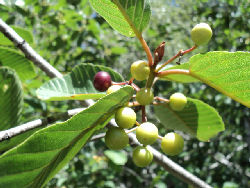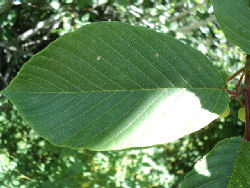

|
|
Practical ecological knowledge for the temperate reader. |
Family: Rhamnaceae - Buckthorn Family
 |
|
"This herb, which has had a place in the U.S. Pharmacopoeia since 1890, is one of the most popular herbal medicines in the world. It is included in many over-the-counter laxatives and is prescribed more than 2.5 million times a year."[PDBHM]
"As well as its uses as a laxative, it is taken internally in the treatment of digestive complaints, haemorrhoids, liver problems and jaundice[238]." [PFAF] "Described in folk medicine, as an internal treatment for diabetes and used externally for skin irritations (6)." [WHO,2,1999]
Synonyms
General "Deciduous shrub or small tree up to 10 m tall..."[IFBC][E-flora] "thin, smooth, silver-grey, numbingly bitter bark." [PCBC2004]
Flowers "...stalked cluster of 8-25 male and/or female flowers; petals 5..."[IFBC][E-flora] "...greenish, inconspicuous, bearing both stamens and pistils..." [HNW] "...stamens: 8-50 in stalked, umbrella-shaped clusters in the axils of leaves." [PCBC2004]
Fruits Berries. Black to purplish-black; seeds 3.[IFBC] [E-flora]
Leaves "Alternate, egg-shaped to broadly elliptic..."[IFBC][E-flora] "...may seem almost opposite on
new growth...young plants may retain their foliage over mild winters".[PCBC2004]
Habitat Streambanks, thickets, woodlands and forests.[IFBC][E-flora] Open woods.[HNW]
Range Common in SW B.C.[IFBC][E-flora] "...often shady sites...swampy bottomlands with red alder..."[PCBC2004]
Status Native. [E-flora]
Medicinal Use:
Bark
Cascara – Rhamnus purshiana [Dukephyt]
| Part: | Seed | PPM | |||
| Protein | 25% [15028] | Riboflavin (mg) | - | Calcium (mg) | - |
| Part: | Bark | PPM & % |
| Food Energy (Kcal) | 2370 ppm [PED] | Ash | 1.9-6.7% [PED98] | Potassium | .11-.40% [PED98] |
| Water | 72.3% [PED98] | Thiamine (PPM) | 0 [PED98] | Magnesium (PPM) | 440-1590 [PED98] |
| Protein | 2.52-9.1% [PED98] | Riboflavin (PPM) | 0 [PED98] | Calcium (PPM) | 4100-14800 [PED98] |
| Fat | .89-3.2% [PED98] | Niacin (PPM) | 8-29 [PED98] | Phosphorus (PPM) | 158-570 [PED98] |
| Carbohydrate (PPM) | 22.4-80.9% [PED98] | Sugars | 1.39-5% | Sodium (PPM) | 26-93 [PED98] |
| Crude Fiber | 31% [PED98] | Dietary Fiber | 56% [PED98] | Iron (PPM) | 6.4-23 [PED98] |
| Chromium (PPM) | 0.2-0.6 | Manganese (PPM) | 0.4-1.4 [PED98] | Selenium (PPM) | 0.3-1.1 [PED98] |
| Cobalt (PPM) | 3.2-11.6 [PED98] | Tin (PPM) | 1.4 - 5.1 [PED98] | Silicon (PPM) | N/A [PED98] |
| Zinc | N/A [PED98] |
|
Antibacterial (1; HH2); [HMH Duke] |
Diuretic (f; CRC); [HMH Duke] |
"The fresh bark of cascara sagrada contains free anthrones," anthrone - glycosides, "aloe - emodin - O - glycoside, and dianthrones... During the drying process, the free anthrones and their corresponding O - glycosides are oxidized...to diminish the emetic properties of the bark extract. Bacterial...activity converts the inactive anthraquinone - O -glucosides into the pharmacologically active aglycon anthrones." [TNS]
| Cascara – Rhamnus purshiana - Plant [Dukephyt] | |||
| Anthraquinone -> glycoside | Aloin | Plant (Duke1992A)[Dukephyt] | |
| Anthraquinone -> | Cascarin | Plant (Duke1992A)[Dukephyt] | |
| Anthraquinone -> | Emodin | Plant (411)[Dukephyt] | |
| Anthraquinone -> O-glycoside | Emosin-oxanthrone | Plant (CAN)[Dukephyt] | |
| Anthraquinone -> | Isoemodin | Plant (LAF)[Dukephyt] | |
| Fatty Acid -> | Linoleic-Acid | Plant (Duke1992A)[Dukephyt] | |
| Fatty Acid -> | Myristic-Acid | Plant (Duke1992A)[Dukephyt] | |
| - | Oxanthrone | Plant (Duke1992A)[Dukephyt] | |
| - | Purshianin | Plant (Duke1992A)[Dukephyt] | |
| - | Quebrachol | Plant (Duke1992A)[Dukephyt] | |
| - | Rhamnol | Plant (Duke1992A)[Dukephyt] | |
| - | Rhamnustoxin | Plant (Duke1992A)[Dukephyt] | |
| trihydroxybenzoic acid -> | Syringic-Acid | Plant (CAN)[Dukephyt] | |
| polyphenol -> | Tannic-Acid | Plant (Duke1992A)[Dukephyt] | |
| Cascara – Rhamnus purshiana - Bark[Dukephyt] | |||
| Anthraquinone -> glycoside | Cascarosides | Bark 4-6.5%(Duke1992A)[Dukephyt] | |
| Anthraquinone -> glycoside | Barbaloin | Bark (LAF 15285) [Dukephyt] | |
| - | Anthranol | Bark (14650)[Dukephyt] | |
| Phenolic -> | Anthroquinones | Bark 6-10% (LAF)[Dukephyt] | |
| - | Ascorbic Acid | Bark 0 (PED98)[Dukephyt] | |
| terpenoid -> | Beta-carotene | Bark 13-46 ppm (PED98) [Dukephyt] | |
| - | Casanthranol | Bark (Duke1992A)[Dukephyt] | |
| - | Cassiamin-C | Bark 120ppm (15286)[Dukephyt] | |
| anthraquinone -> | Chrysophanic-Acid AKA (Chrysophanol) | Bark (LAF 15289 15286 19313 15285)[Dukephyt] | |
| C-glycosides -> | Deoxybarbaloin AKA (Chrysaloin) | Bark (Duke1992A)[Dukephyt] | |
| - | Emodin-Anthrone | Bark (19313)[Dukephyt] | |
| - | Frangulaemodin | Bark (15285 16729)[Dukephyt] | |
| - | Frangulin | Bark (LAF PED)[Dukephyt] | |
| Anthraquinones -> | Palmidins | Bark (411)[Dukephyt] | |
| anthraquinone derivative -> | Physcion | Bark (15289 19313 15286 15285)[Dukephyt] | |
| - | Resins | Bark (LAF)[Dukephyt] | |
| polyphenol -> | Tannins | Bark (LAF)[Dukephyt] | |
"Succeeds in any reasonably good soil in sun or partial shade[11, 238]. This species is hardy to at least -15°c[238]. Closely related to R. frangula[11]. This species is cultivated as a medicinal plant in N. America[57, 60, 61] and is also collected from the wild[238]. It is becoming rare in the wild because of over-collection[238]. The flowers are produced in small clusters on shoots of the current year's growth[82]. A good bee plant[94]. The species in this genus are notably resistant to honey fungus[200]." [PFAF]
"Seed - best sown in the autumn in a cold frame. Stored seed will require 1 - 2 months cold stratification at about 5° and should be sown as early in the year as possible in a cold frame or outdoor seedbed[200]. Prick out the seedlings into individual pots when they are large enough to handle, and grow them on in the greenhouse or cold frame for their first winter. Plant them out in late spring or early summer of the following year. Cuttings of half-ripe wood, July/August in a frame[113]. Cuttings of mature wood of the current year's growth, autumn in a frame. Layering in early spring[4]."[PFAF]
Family: Rhamnaceae - Buckthorn Family
Shrub, small tree, < 10 m. Stem: branches alternate, stiff or flexible; twigs generally not thorn-tipped; winter bud scales present, generally ± 3 mm. Leaf: scattered along branches or clustered on short-shoots, deciduous or evergreen; stipules generally deciduous; petioles generally glabrous; blade veins prominent or not. Inflorescence: flowers 1 or in cyme-like clusters in axils. Flower: unisexual (bisexual), generally on separate plants, generally < 3 mm; hypanthium bell-shaped to cup-like, 2–3 mm wide; sepals 4–5, thin, spreading, not keeled adaxially; petals 0 or 4–5; disk thin, adhering to hypanthium; ovary appearing superior or partly inferior, chambers 2–4, each 1-ovuled, style 1, stigma 2–4-lobed. Fruit: drupe, 2–3[4]-stoned.
110 species: temperate, few tropics; some of value in medicine or as dyes. (Greek: name for plants of this genus) [Bolmgren & Oxelman 2004 Taxon 53:383–390] W.H. Brewer collected Rhamnus cathartica L., considered invasive in parts of United States, in 1861, but it apparently never naturalized. Other taxa in TJM (1993) moved to Frangula. [Jepson]
Local Species;
The Alder Buckthorn, Rhamnus Frangula, also a native of Europe, is used for "making the best charcoal for the finest gunpowder." It has been introduced in a few swampy places about New York. Its fruit is disagreeable.[EWP]
"Both R. californica and the closely related R. purshiana have been referred to as cascara sagrada. Today, however, the name cascara sagrada is used most often to designate R. purshiana. Although both species can be used as a laxative, R. purshiana is preferred."[Nyerges]